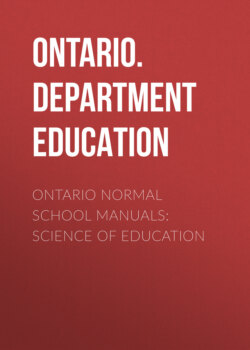Читать книгу Ontario Normal School Manuals: Science of Education - Ontario. Department of Education - Страница 14
CONSCIOUS REACTION
ОглавлениеAn Example.—The third and highest form of human reaction is known as ideal, or conscious, reaction. In this form of reaction the mind, through its present ideas, reacts upon some situation or difficulty in such a way as to adjust itself satisfactorily to the problem with which it is faced. As an example of such a conscious reaction, or adjustment, may be taken the case of a young lad who was noticed standing over a stationary iron grating through which he had dropped a small coin. A few moments later the lad was seen of his own accord to take up a rod lying near, smear the end with tar and grease from the wheel of a near by wagon, insert the rod through the grating, and thus recover his lost coin. An analysis of the mental movements involved previously to the actual recovery of the coin will illustrate in general the nature of a conscious reaction, or adjustment.
Factors Involved in Process.—In such an experience the consciousness of the lad is at the outset occupied with a definite problem, or felt need, demanding adjustment—the recovering of the lost coin, which need acts as a stimulus to the consciousness and gives direction and value to the resulting mental activity. Acting under the demands of this problem, or need, the mind displays an intelligent initiative in the selecting of ideas—stick, adhesion, tar, etc., felt to be of value for securing the required new adjustment. The mind finally combines these selected ideas into an organized system, or a new experience, which is accepted mentally as an adequate solution of the problem. The following factors are found, therefore, to enter into such an ideal, or conscious, reaction:
1. The Problem.—The conscious reaction is the result of a definite problem, or difficulty, presented in consciousness and grasped by the mind as such—How to recover the coin.
2. A Selecting Process.—To meet the solution of this problem use is made of ideas which already form a part of the lad's present experience, or knowledge, and which are felt by him to have a bearing on the presented problem.
3. A Relating Process.—These elements of former experience are organized by the child into a mental plan which he believes adequate to solve the problem before him.
4. Application.—This resulting mental plan serves to guide a further physical reaction, which constitutes the actual removal of the difficulty—the recovery of the coin.
Significance of Conscious Reactions.—In a conscious reaction upon any situation, or problem, therefore, the mind first uses its present ideas, or experience, in weighing the difficulties of the situation, and it is only after it satisfies itself in theory that a solution has been reached that the physical response, or application of the plan, is made. Hence the individual not only directs his actions by his higher intelligent nature, but is also able to react effectively upon varied and unusual situations. This, evidently, is not so largely the case with instinctive or habitual reactions. For efficient action, therefore, there must often be an adequate mental adjustment prior to the expression of the physical action. For this reason the value of consciousness consists in the guidance it affords us in meeting the demands laid upon us by our surroundings, or environment. This will become more evident, however, by a brief examination into the nature of experience itself.
